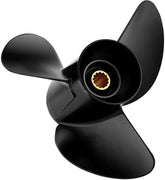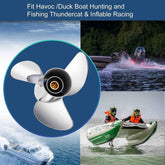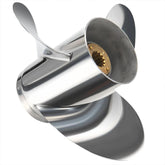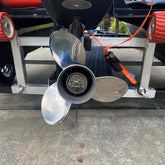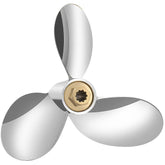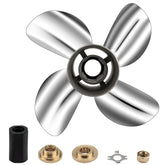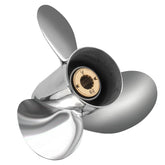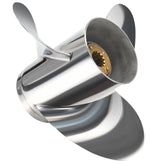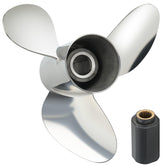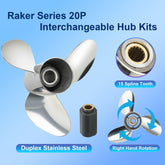Boat Propeller Size, Pitch, and Material Explained
When a boat feels sluggish off the plane, over-revved at full throttle, or vibrates at certain speeds, the propeller is almost always the most likely cause. After years working at ramps and service bays I’ve seen the same errors repeated: buying a prop because it “fits the brand,” guessing pitch without testing under real load, and expecting the empty-boat numbers to hold when the family and gear are aboard. This guide strips away the noise and explains the three levers that actually change a boat’s behavior — size (diameter), pitch, and material — and shows the exact test routines, diagnosis steps and buying flow I use with customers to get a reliable result the first time.
If you want to see how propellers are made and why tight manufacturing tolerance matters to field performance, read the factory walkthrough at How Boat Propellers Are Manufactured https://vifmarine.com/how-boat-propellers-are-manufactured/. If you want to browse compatible, engine-specific replacement props with compatibility matrices and U.S. warehousing, start at the Boat Propeller Online store https://vifprop.com/ or jump to collections for specific engines like Yamaha https://vifprop.com/collections/propeller-for-yamaha and Mercury https://vifprop.com/collections/propeller-for-yamaha.
How diameter, pitch, and material move a boat
A propeller is the gearbox between your engine and the water. Diameter controls the volume of water moved each revolution, pitch controls the theoretical distance the prop moves per revolution, and material determines how thin and hydrodynamic the blade sections can be made.
Diameter behaves like torque: more diameter equals more low-end bite and better planing for heavy hulls. Pitch behaves like a gear: more pitch gives a higher theoretical top speed but reduces acceleration and requires more torque to spin. Material — usually aluminum or stainless steel in outboard applications — dictates how finely the blades can be profiled and how they respond to impacts. Stainless allows thin, stiff sections that keep their shape at high RPM and in sustained use; aluminum is thicker, less efficient at the top end, but bends rather than transmitting all the strike energy to your lower unit.
Those three choices are interdependent. A tall pitch on too small a diameter will cavitate. A thin stainless blade with too much pitch on a light hull will ventilate and lose bite. The practical job of tuning a prop is finding the sweet spot for your particular hull, engine, and typical load.
For modern factory-grade parts and consistent tolerances, check the manufacturer overview at the Boat Propeller Manufacturer page https://vifmarine.com/ and learn why CNC pitch checks and dynamic balancing reduce surprises in the field.
Why pitch is the primary tuning lever
If you only remember one tuning rule, remember this: pitch controls whether the engine sits in its correct wide-open-throttle band when the boat carries its normal load. If your WOT RPM is below the manufacturer’s recommended band, you need less pitch. If WOT RPM is above the band, you need more pitch. A field rule of thumb is that one inch of pitch changes RPM by roughly 150–200 RPM on many outboards, but that number shifts with hull shape and gearing. The only reliable way to choose pitch is by measured, on-water testing.
Diameter gives you low-end presence
Diameter sets the prop’s low-speed authority. Increasing diameter increases the mass of water pushed per revolution, improving hole-shot and reducing the tendency to cavitate under heavy loads. Diameter choices are often limited by clearance and skeg geometry; the largest usable diameter that clears the skeg without rubbing is usually the right starting point.
How material affects real performance
Material decisions are practical. Stainless steel delivers higher efficiency because blades can be made thinner and with better sections; that translates into higher top speed and better cruise fuel economy for the same engine RPM. Aluminum is less efficient at the top end but is inexpensive and sacrificial — it often bends instead of transferring impact loads into the lower unit. The common, practical compromise many owners adopt is stainless for daily use and an aluminum spare on the trailer for shallow launches or accidental strikes.
If you want to purchase both kinds in one place and verify compatibility by engine, the Boat Propeller Online store https://vifprop.com/ organizes props by engine and material so you can assemble a stainless daily prop and an aluminum spare in one checkout.
Reading the numbers and the transom tag
A prop marked 14 x 19 means a 14-inch diameter and a 19-inch pitch. Your transom tag, however, is the single most important source of truth: it lists engine make, model year, and often a gearcase code. The gearcase code maps to spline count and hub family, and those details determine whether a prop will physically mate and transfer torque correctly. If the transom tag is faded, remove the prop and photograph the hub and splines.
When shopping online, insist on product pages that include compatibility matrices listing engine models, years and gearcase codes. If a listing says only “fits Yamaha” without those specifics, do not buy it. For convenience you can browse engine-filtered collections like the Yamaha collection https://vifprop.com/collections/propeller-for-yamaha, the Mercury collection https://vifprop.com/collections/propeller-for-yamaha, or other manufacturer pages for Honda https://vifprop.com/collections/propeller-for-honda, Suzuki https://vifprop.com/collections/propeller-for-suzuki, Volvo https://vifprop.com/collections/propeller-for-volvo and Tohatsu https://vifprop.com/collections/propeller-for-tohatsu.
The controlled on-water test routine I use
Treat prop swapping like a controlled experiment. Control everything except the one variable you are testing.
Prepare the boat by cleaning hull growth, setting trim tabs and trim positions to how you normally run, and loading the boat with the people and gear you usually carry. Warm the engine to operating temperature; cold runs produce misleading numbers. Run two to three wide-open-throttle passes in the same heading to minimize the effects of wind and current, and record GPS speed and tachometer for each pass. Average the readings.
Calculate theoretical speed with the formula: theoretical mph = (pitch in inches × RPM) ÷ 336. Then compute slip as slip % = (1 − GPS speed ÷ theoretical speed) × 100. For most planing hulls, you want roughly 10–25% slip at WOT with your typical load. Use WOT RPM to evaluate pitch and slip to evaluate blade area and geometry.
Change only one variable at a time between test days: pitch first, blade count next, then cupping or rake. If possible, order the baseline and one alternate ahead of the test day so you can do same-day comparisons. The hot-selling models page https://vifprop.com/collections/hot-selling is a practical place to find commonly tested shapes such as YBS, Chopper and Vengeance for baseline vs alternate experiments.
Diagnosing strikes and failures: three quick triage checks
When something goes wrong, symptoms quickly point to one of three problems: spun hub, bent blade, or lower-unit damage.
If the engine revs but the boat doesn’t move, remove the prop and hand-rotate the hub. If the prop spins on the shaft or the elastomeric insert is shredded, you likely have a spun hub. Flo-Torq insert kits often fix this quickly on Mercury-style hubs. If splines are rounded, tow to a shop and avoid running the engine.
If the boat vibrates heavily at certain speeds, bench-spin the prop and check tip runout. Small aluminum bends can be straightened and dynamically balanced; stainless repairs risk cracking and are often best replaced.
If lower-unit oil looks milky, has metal flakes, or smells burnt, stop the engine and tow to a shop. Those signs indicate internal gear or bearing failure and continuing to run will exponentially increase repair cost.
Carrying a simple trailer kit — an aluminum spare prop, a Flo-Torq insert kit if your hub uses it, a prop nut socket and a phone for photos — solves many weekend issues. When you need compatible replacements fast, use the Boat Propeller Online store https://vifprop.com/ and the engine collections to find matching SKUs.
Hub types and why they matter
Hub compatibility is the most common reason for returns and installation headaches. Flo-Torq elastomeric insert hubs, common on many Mercury gearcases, allow fast insert replacement and absorb shock. Solid splined bores, common on Yamaha, Honda and Suzuki units, require exact spline counts. Always verify spline count and hub type before buying a replacement. If a product page lacks a compatibility matrix, request verification from the seller and send clear photos of the transom tag and hub.
For Mercury and Yamaha owners, use the dedicated engine pages to narrow options quickly: Yamaha props https://vifprop.com/collections/propeller-for-yamaha and Mercury props https://vifprop.com/collections/propeller-for-yamaha include compatibility detail to reduce fitment errors.
Repair vs replace — practical guidance
Aluminum props are often economical to straighten and balance for minor bends. Stainless blade repairs are more expensive and can introduce stress points that lead to cracking; in many cases replacing stainless is the safer, long-term option. Replacing a Flo-Torq insert is inexpensive and restores torque transfer without changing the prop. Lower-unit repairs are the costly category; if oil shows metal flakes or water, plan on towing and professional diagnosis.
Balance repair costs against downtime and future risk. If you need parts or want to compare reasonable replacements, the Boat Propeller Online store https://vifprop.com/ provides engine filters and material options so you can make informed purchases.
Practical buying flow that reduces returns
When a customer asks for a shopping checklist I give this exact sequence. Photograph the transom tag and the old prop hub including any stamped gearcase codes. Use product pages that include compatibility matrices to match SKU to gearcase code and spline count. If anything is unclear, upload photos to support for confirmation; never guess on spline counts. Order a baseline prop plus one alternate (±1″ pitch or a four-blade) and an aluminum spare if you run shallow water. Choose U.S. warehouse shipping for fast delivery when available. Test both props on the water with your normal load and keep all packaging until you are satisfied; document test passes for returns.
To begin shopping, use the centralized Boat Propeller Online store https://vifprop.com/ or browse engine collections for a faster match: Yamaha https://vifprop.com/collections/propeller-for-yamaha, Mercury https://vifprop.com/collections/propeller-for-yamaha, Suzuki https://vifprop.com/collections/propeller-for-suzuki, Honda https://vifprop.com/collections/propeller-for-honda, Volvo https://vifprop.com/collections/propeller-for-volvo and Tohatsu https://vifprop.com/collections/propeller-for-tohatsu.
Installation notes that prevent common mistakes
When installing, reassemble thrust washers and spacers in the exact original order. Incorrect spacer order is a frequent cause of hub slip and vibration. Torque the prop nut to manufacturer spec and secure the cotter pin correctly. Run a short, low-speed shakedown before WOT to check for vibration. If you change diameter or tip shape, verify skeg clearance and trim behavior. Keep packaging and photos for warranty or return use.
Examples from the ramp: how small changes helped real boats
I once tuned a tournament bass boat that would not plane with the usual load. The owner had a prop sized for an empty boat; WOT RPM was in the maker band but the boat was slow to plane. We switched to a four-blade stainless with slightly lower pitch and the boat reached plane faster under load; slip tightened and hole-shot improved — the owner kept the four-blade for tournaments and an aluminum spare for launches.
A family pontoon arriving with harsh midrange vibration turned out to have a bent aluminum spare installed by a previous owner. A dynamically-balanced stainless replacement designed for loaded pontoons smoothed the ride and improved fuel economy. These real outcomes are the reason controlled testing and fit verification matter.
FAQ: concise answers to common questions
What does a marking like 14 x 19 mean on a prop? It means 14-inch diameter and 19-inch pitch.
How much RPM change per inch of pitch? A field estimate is 150–200 RPM per inch for many outboards; confirm on the water because hull and load influence the result.
Is stainless always better than aluminum? Stainless provides better performance and shape retention; aluminum is cheaper and sacrificial. Many owners run stainless daily and keep aluminum as a trailer spare.
Can I use a Yamaha prop on a Mercury engine? Only if spline count, hub type and rotation match exactly. Don’t assume cross-brand compatibility; verify via compatibility matrix or photo verification.
Where can I buy compatible props and check fit? Start at the Boat Propeller Online store https://vifprop.com/ and use engine collections such as Yamaha https://vifprop.com/collections/propeller-for-yamaha and Mercury https://vifprop.com/collections/propeller-for-yamaha. For tournament and popular performance shapes see the hot-selling models at https://vifprop.com/collections/hot-selling.
Where to learn more about manufacturing and quality control
If you want to understand why small pitch deviations or poor balance produce big performance differences, read the manufacturing deep-dive at How Boat Propellers Are Manufactured https://vifmarine.com/how-boat-propellers-are-manufactured/ and review the company capabilities at the Boat Propeller Manufacturer page https://vifmarine.com/. Suppliers who publish their QC steps and compatibility matrices make the buying journey much more predictable.
If you’d like, paste your transom tag details and upload a clear photo of the old hub and splines here and I’ll recommend two specific SKUs to test — one baseline and one alternate — that match your gearcase code and will get you on the water testing with confidence. For immediate browsing, use the Boat Propeller Online store https://vifprop.com/ and the engine collections for Yamaha, Mercury, Honda, Suzuki, Volvo and Tohatsu listed above.


